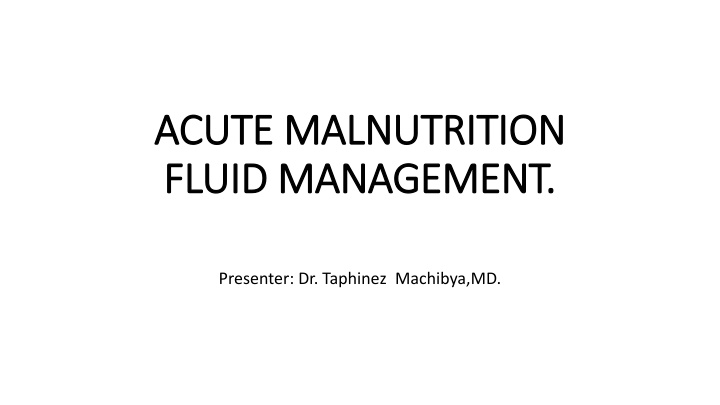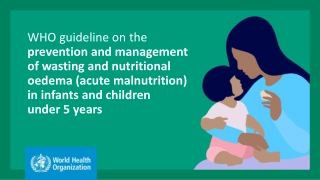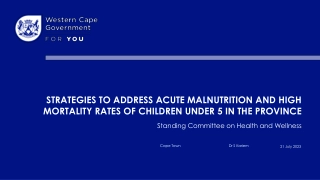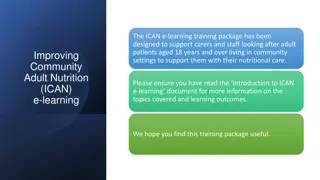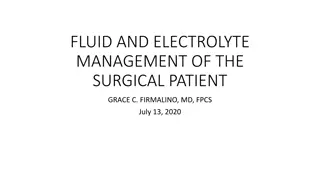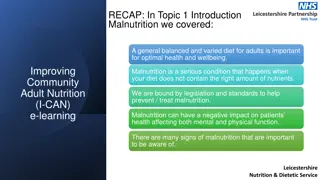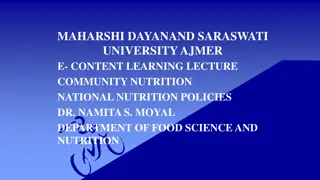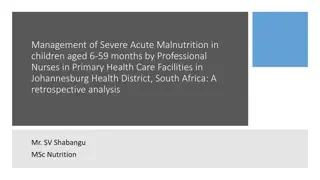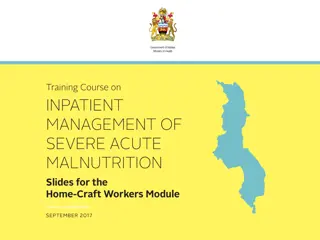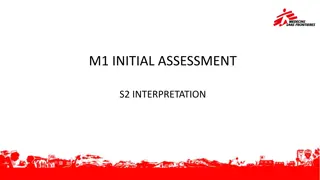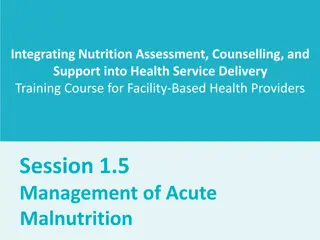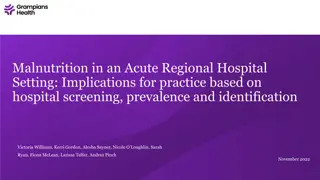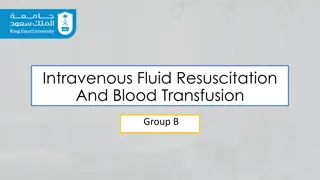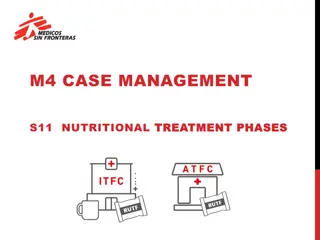Acute Malnutrition - Fluid Management and Treatment Overview
Acute malnutrition, particularly severe acute malnutrition (SAM), requires careful fluid management and a structured treatment approach involving stabilization, transition, and rehabilitation phases. This condition results from inadequate dietary intake or acute infections, leading to severe wasting and edema. The treatment includes addressing complications like hypoglycemia, dehydration, electrolyte imbalances, infections, and providing micronutrient supplementation. Preventing dehydration is crucial, involving rehydrating solutions and zinc supplementation, alongside dietary management and emotional support.
Download Presentation

Please find below an Image/Link to download the presentation.
The content on the website is provided AS IS for your information and personal use only. It may not be sold, licensed, or shared on other websites without obtaining consent from the author.If you encounter any issues during the download, it is possible that the publisher has removed the file from their server.
You are allowed to download the files provided on this website for personal or commercial use, subject to the condition that they are used lawfully. All files are the property of their respective owners.
The content on the website is provided AS IS for your information and personal use only. It may not be sold, licensed, or shared on other websites without obtaining consent from the author.
E N D
Presentation Transcript
ACUTE MALNUTRITION ACUTE MALNUTRITION FLUID MANAGEMENT. FLUID MANAGEMENT. Presenter: Dr. Taphinez Machibya,MD.
INTRODUCTION Acute Malnutrition (wasting) is a rapid decline of weight while height remains unchanged. It is a reflection of inadequate dietary intake or acute infection. It is classified into severe acute malnutrition (SAM) and moderate acute malnutrition (MAM) according to the degree of wasting and the presence or absence of oedema.
SEVERE ACUTE MALNUTRITION SEVERE ACUTE MALNUTRITION It is defined as edema of both feet and visible severe wasting Diagnostic Criteria Visible severe wasting Edema of both feet Weight for length/height <-3SD MUAC < 11.5 cm
Investigations Investigations RBG BS for MPS Septic screening; Urine culture, Blood culture, Swab cultures FBP HIV screening Chest X ray
Treatment of Severe Acute Malnutrition Treatment of Severe Acute Malnutrition The management of severe malnutrition involves 10 steps in three Phases: stabilization, transition and rehabilitation. Those 10 steps are; i. Hypoglycemia (RBG <3mmol/L or 54 mg/dL ) ii. Hypothermia (Axillary temp <35 C or Rectal temp<35.5 C) iii. Dehydration iv. Electrolytes imbalance v. Infections vi. Micronutrients supplementation vii. Dietary management viii. Growth - Catch up (Recover Lost weight) ix. Sensory Stimulation and Emotional Support x. Prepare for Discharge and Follow up
PHASES Stabilization: This is the initial phase in the management of SAM where by acute complications and metabolic derangements are addressed. Treat Complications like: Hypoglycaemia (bolus of 10% glucose IV 5ml/kg or 50ml of 10% glucose or sugar water by NGT for unconscious, lethargic or convulsing child.) Hypothermia, Dehydration Electrolytes Micronutrients
Treat/Prevent Dehydration Treat/Prevent Dehydration Assume dehydration if there is a recent history of diarrhea and/or vomiting Give Rehydrating Solution for Malnutrition (ReSoMal) 5ml/kg every 30 minutes for 2 hours, then 10ml/kg/hr alternating hourly with F-75 for the next 4-10 hours If ReSoMal is unavailable give half strength ORS. Give Zinc PO 20mg (children six months or older) or 10mg (children less than six months) once a day for ten days. Continue breast feeding throughout treatment. Note: Do not give IV fluids in severely malnourished children except in shock. Do not give ReSoMal in case of profuse watery diarrhoea (e.g. Cholera), instead give ORS without changing the amount and frequency.
Prevention of dehydration Prevention of dehydration; Give ReSoMal after every watery stool as follows: For children <2years, give 50-100 ml after each watery stool. For children >2years, give 100-200 ml after each watery stool.
Shock management in a child with severe Shock management in a child with severe malnutrition malnutrition Give this treatment only if the child has signs of shock and is lethargic or has lost consciousness Determine the weight of the child Give IV fluids 15ml/kg over1hour. Use one of the following solutions (in order of preference) according to availability: - RL with 5% glucose (dextrose) - 0.45% NaCl plus 5%Dextrose - Plain RL
Shock management in Malnutrition. Measure the pulse and breathing rate at the start and every 5-10 minutes If there are signs of improvement: Repeat IV 15ml/kg over 1hour, then switch to oral or nasogastric rehydration with ReSoMal, 10ml/kg/h up to 10 hours; Then; Initiate re-feeding with starter F-75. If the child fails to improve after the first 15ml/kg IV, assume the child has septic shock. Give maintenance IV fluid (4ml/kg/h) while waiting for blood; When blood is available, transfuse fresh whole blood at 10ml/kg slowly over 3 hours (use packed RBC if in cardiac failure);
Shock management in Malnutrition. Then Initiate feeding with starter F-75. Start antibiotic treatment. Note: If the child deteriorates during the IV rehydration (breathing increases by 5 breaths/min or pulse by 15 beats/min), stop the infusion because IV fluid can worsen the child s condition.
Correct Electrolyte imbalance Correct Electrolyte imbalance Give extra Potassium 3 mmol/kg/d. Give extra Magnesium 0.4 mmol/kg/d. When rehydrating, give ReSoMal. Prepare food without salt.
Treatment of Infections Treatment of Infections Give Ampicillin IV 50mg/kg 6 hourly for 2 days then Amoxycilin DT PO 40 mg/kg/dose 12 hourly for 5 days AND Gentamicin IV 7.5mg/kg once daily for 7 days.
Micronutrients Supplementation Micronutrients Supplementation Folic acid 5 mg on Day 1 then 1mg daily for 3 months Give Iron 3mg/kg once a day for 3 months to be given during Rehabilitation Note: Commercially prepared F-75/F-100/ and Ready to Use therapeutic Food (RUFT) contains micronutrients thus do not require extra micronutrient supplements
Dietary management Dietary management Give F-75 11mls/kg 2 hourly (12 feeds/day) OR For stable children F-75 16mls/kg 3hourly (8 feeds/day). If a child has severe oedema, give F-75 8.5mls/kg 2 hourly OR For stable children F-75 12.5mls/kg 3 hourly Note; Do not give food other than F75 and breast milk OR Simply; For Edematous malnourished children: 100mls/kg/24hrs For Non-edematous malnourished children: 130mls/kg/24hrs Then divide the dosage according to hourly periods.
Transition Phase Transition Phase Is a short period between stabilization and rehabilitation phase to assess if the child can tolerate F-100. Criteria to move from Stabilization Phase to Transition Phase: 1. Appetite has improved 2. Loss of, or minimal oedema 3. Treatment of medical complications has commenced and patient has improved. 4. IV fluids and NGT feeding completed. 5. Child can take feeds orally .
NOTE: In Transition Phase Dietary Management Replace F-75 feeds with the same amount of F-100 for the first 2 days. On the third day, increase amount of F100 given by 10mls in each successive feed as long as child finishes feeds.
Rehabilitation Phase Rehabilitation Phase This phase is associated with full recovery and rapid catch up of lost weight. In this phase use either F 100 or Ready to Use Therapeutic Food (RUTF). Dietary Management Give 25mls/kg of F-100 3 hourly. RULES FOR RUTF Do Appetite test. If passed Give 200 kcal/kg/day of RUFT. Encourage drinking water after eating RUTF. Give additional foods if demanded as long as full amount of prescribed RUTF has been consumed. NOTE*The calculation based on RUTF sachets of 92g that provides 500 kcal
SENSORY STIMULATION AND EMOTIONAL SUPPORT SENSORY STIMULATION AND EMOTIONAL SUPPORT Provide: Tender loving care A cheerful stimulating environment Structured play therapy for 15 30 minutes a day Physical activity as soon as the child is well Support for maternal involvement
Discharge and Follow up Monitor weight weekly If there is weight loss or no weight gain readmit Discharge from outpatient Follow Up If weight for length/height is at least -2SD OR MUAC is at least 12.5cm
DONTs Stop all oral intake and IV fluids during blood transfusion. Stop blood transfusion if a child develop fluid overload. Do not give iron in stabilization and transition phases of Treatment. Do not repeat blood transfusion within 4 days
References Tanzania PEDIATRIC STG, 1stEdition October, 2017. Intergrated Management of Childhood Illness- WHO guideline, 2010 WHO pocket book of Hospital care for Children, 2ndEdition, 2013.
